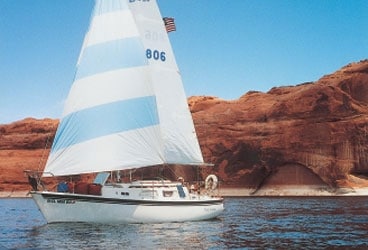
Balboa 26
Arthur Marine, of Costa Mesa, California, introduced the Lyle Hess-designed Balboa 26 in 1969, billing it as the largest trailerable sailing cruiser on the market. Coastal Recreation took over production in about 1972 and closed its doors in 1981. But the boat continues to enjoy a strong following among budget-minded cruisers.
The hull is heavily built with hand-laid fiberglass, and the boat is reinforced at all stress points with marine plywood laminated to the hull, deck, and cabin top. An integral fiberglass hull liner provides additional strength. A few boats were built with a fixed keel and an inboard engine.
The self-bailing cockpit accommodates four people comfortably. Seat lockers provide plenty of storage, and a self-draining outboard-motor well is located aft, clear of all running rigging.
The teak-trimmed saloon has 5-foot-6-inch headroom. There’s a dinette to port that converts to a double berth, and a settee lies to starboard. A Balboa feature is the world map incorporated into the laminate tabletop. Shelves outboard to port and starboard provide storage, supplementing numerous other compartments located beneath the settee, the V-berth, and the dinette seats. A shag carpet was the standard cabin-sole covering; teak was an option.
The galley is directly under the oversize entry hatch. It contains an icebox and is fitted with an alcohol stove and a sink with a manual freshwater pump. The forward cabin has a partitioned area for a portapotti or an optional marine head, a hanging locker, and a double V-berth. This compact area also contains a sink and manual pump. A hatch provides fresh air, and on later models, port and starboard ports were added to admit more light. Nominally, five can sleep on the Balboa 26, but experience suggests that the optimum number is two or three.
Under sail, the Balboa 26 is quite stiff. The boat is fast and maneuverable, but it’s a handful for a novice sailor. The 26 has noticeable weather helm, and the tiller requires constant attention. As with most boats of this type, the swing keel has a tendency to rumble at hull speed, which is a little more than 6 knots.
The masthead-rigged spar stands on a hinged aluminum mast step and is supported by fore and aft lowers and in-line cap shrouds, which also brace it while it’s being raised or lowered. A 12:1 winch is used to raise and lower the 1,200-pound swing keel.
Although Balboa 26s have aged well, minor problems sometimes arise: The main chainplates are prone to leaks; the keel trunk is vulnerable around the pivot bolt and can be problematic in the event of grounding; water can splash in where the keel cable exits the trunk, especially in rough water. Some owners have reported the stainless-steel rudderstock bending or even breaking in a broach.
The builder listed the towing weight of the Balboa 26, including the tandem-axle trailer, at 4,500 pounds. However, when it was fully loaded for an extended cruise, our rig never weighed in at less than 6,500 pounds.
Prices can range from $2,000 for a fixer-upper without a trailer to $10,000 for a combination that’s well equipped and nicely maintained.
Matts G. Djos and his wife, Jeanine, live in Colorado and have trailered their 1976 Balboa 26 to cruising grounds from the Pacific Northwest to the Golfo de California.








